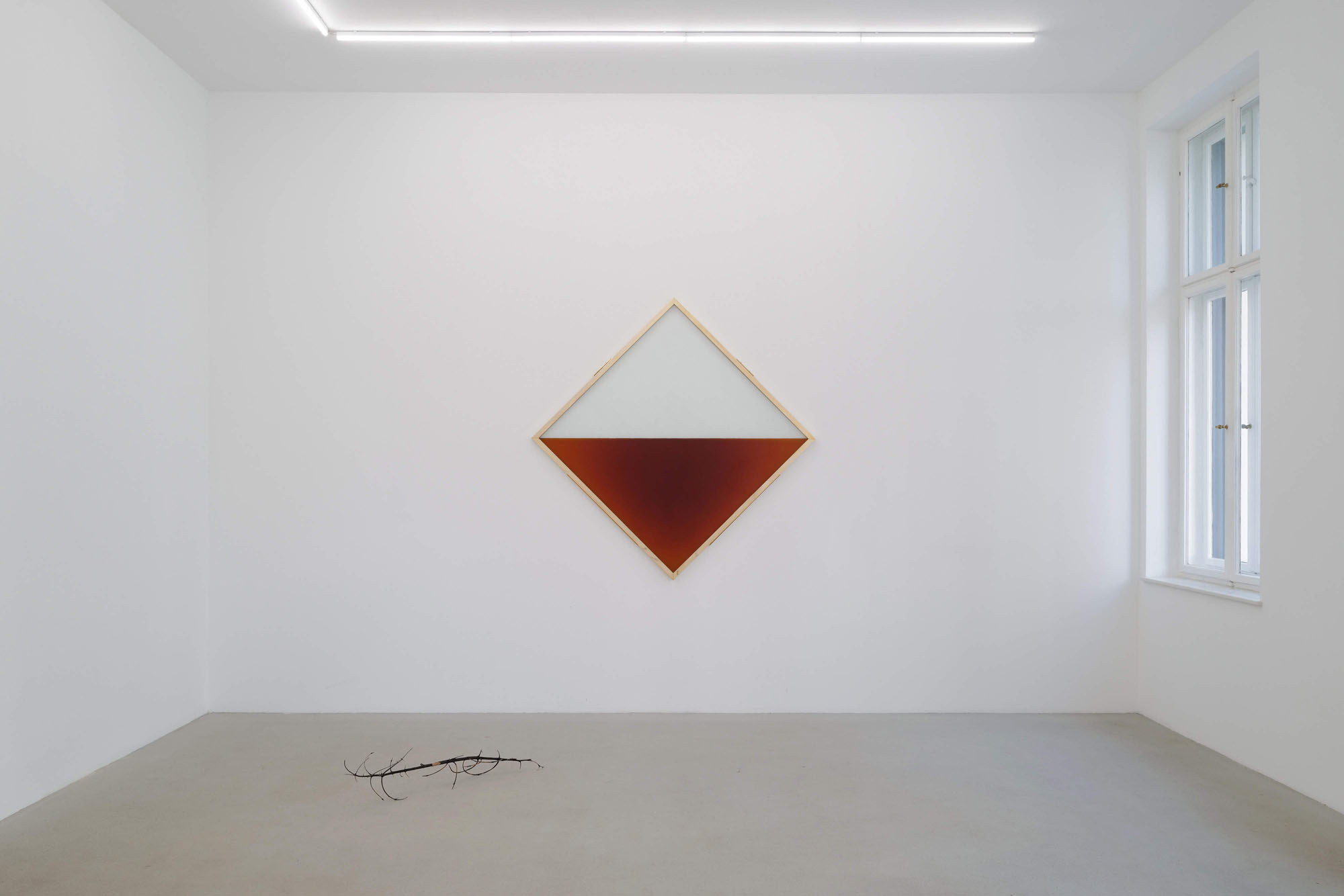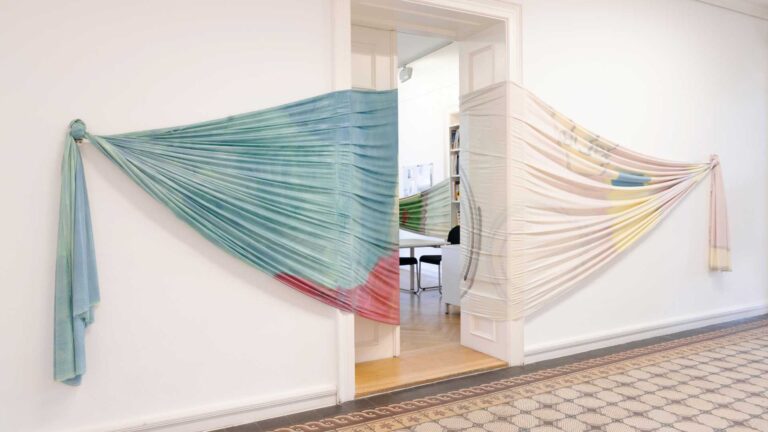Artists: Vajiko Chachkhiani, Reijiro Wada
Exhibition title: A Silent Conversation
Venue: Rolando Anselmi (in collaboration with Daniel Marzona), Berlin, Germany
Date: February 21 – March 28, 2020
Photography: all images copyright and courtesy of the artists, Rolando Anselmi, Berlin/Rome and Daniel Marzona
Daniel Marzona is pleased to present an exhibition with current works by the artists Vajiko Chachkhiani and Reijiro Wada in the Galerie Rolando Anselmi.
The idea for this exhibition arose when thinking about possible strategies of processualism in contemporary sculpture. The works of Wada and Chachkhiani initially seem to mark two opposite conceptual and substantive poles in this field. While the one deals more with abstract ideas and brings them to view in flawlessly beautiful objects, the reflection of the other seems to be always tied to very concrete events, personal encounters, or psychological dispositions. If a group of strictly geometrical wax sculptures (“The Other Life”) by Chachkhiani thus has its starting point in the protracted development of a trusting relationship with someone imprisoned for a serious crime, or if a short film of his (“Life Track”) would not have been possible without countless visits to a hospice in Berlin, Wada, on the other hand, works in almost a vacuum of pure ideas, whether he works with questions and philosophical sketches concerning transience or with extremely abstracted concepts of landscape depiction.
What unites the two artists, however, is an increased interest in keeping the form and meaning of their sculptural work open. For the pictorial works in his Vanitas series, Wada places two or more brass plates at a flat angle to each other that makes it possible for fruits thrown with great force into the construction to remain there until they decompose. Once the process of rotting is complete, Wada dismantles the arrangement; hangs the plates in, for example, a diptych on the wall; and leaves the ultimately random traces of this measure on the plates for viewing. For a series of seemingly minimalist wax sculptures, Chachkhiani exchanged a group of objects with a prisoner and placed what he received within his wax works. Accompanying the objects are precise instructions for rearranging the sculpture if the object is ever opened and the object enclosed in it is removed, which the artist regards as definitely possible and a valid way of dealing with the work. Preceding and subsequent processes thus often play an essential role for deciphering or mystifying the meaning of both artists’ work.The wall object with the simple title “Mittag” (midday) shows the high degree of abstraction of Wada’s approach. Wada filled cognac between two glass plates in a square brass frame. Standing on its tip and affixed to the wall, the level of the cognac within the frame is at precisely the height of the object’s outer corners. What we see is thus apparently meant as the horizon line seen at the time when the sun is highest and the shadows shortest – a gaze at the landscape cannot be abstracted more sparely and yet succinctly. But even this seemingly precise object proves to be open to the uncontrolled unfolding of processes. Evaporations condense on the inner sides of the glass plates, depending on the room temperature, as if hinting at an interior climate of the depicted landscape.
For different reasons, Wada’s and Chachkhiani’s seeming proximity to the minimalist tradition proves chimerical. For both go in different ways beyond what their usually quite simple objects provide to see. The one usually uses narrative strategies to this end, while the other seeks to transcend objecthood in philosophical heights. That the two approaches prove open to the widest variety of and sometimes to contradictory interpretations may be regarded as an indication of the quality and complexity of Chachkhiani’s and Wada’s process-oriented sculptural work.
Vajiko Chachkhiani (born 1985 in Tbilisi, Georgia) lives and works in Tbilisi. His work was presented at Georgian Pavilion at the 57th Venice Biennale in (2017). In recent years his work has been shown internationally, with solo exhibitions including at the Bundeskunsthalle Bonn (2018) and Art Basel Unlimited (2019). Reijiro Wada (born 1977 in Hiroshima, Japan) lives and works in Berlin. After a solo exhibition at CAPSULE, Tokyo (2017) his work has been shown at the TBILISI ARCHITECTURE BIENNIAL 2018.
Vajiko Chachkhiani & Reijiro Wada, A Silent Conversation, 2020, exhibition view, Rolando Anselmi (in collaboration with Daniel Marzona), Berlin
Vajiko Chachkhiani & Reijiro Wada, A Silent Conversation, 2020, exhibition view, Rolando Anselmi (in collaboration with Daniel Marzona), Berlin
Vajiko Chachkhiani & Reijiro Wada, A Silent Conversation, 2020, exhibition view, Rolando Anselmi (in collaboration with Daniel Marzona), Berlin
Vajiko Chachkhiani & Reijiro Wada, A Silent Conversation, 2020, exhibition view, Rolando Anselmi (in collaboration with Daniel Marzona), Berlin
Vajiko Chachkhiani & Reijiro Wada, A Silent Conversation, 2020, exhibition view, Rolando Anselmi (in collaboration with Daniel Marzona), Berlin
Vajiko Chachkhiani, Untitled, 2020, wax, hidden object, h = 50, Ø 38 cm
Vajiko Chachkhiani, Unwelcome Thought, 2020, burned tree, 84 x 27 x 13 cm
Vajiko Chachkhiani, Unwelcome Thought, 2020, burned tree, 21 x 107 x 15 cm
Reijiro Wada, SCARLET, VE, 2018, wine, tempered glass, brass, stainless steel, 240 x 12 x 25 cm
Reijiro Wada, MITTAG, 2018, brandy, tempered glass, brass, stainless steel, nitrogen, 170 x 170 x 35 cm
Reijiro Wada, VANITAS, 2018, brass, aluminium honeycomb sandwich panels, fruit acid, 75 x 248 x 35 cm
Reijiro Wada, SCARLET MIRROR, 2017, wine, glass, brass, stainless steel, 30 x 30 x 5 cm


















